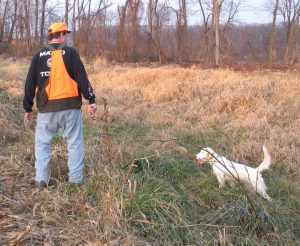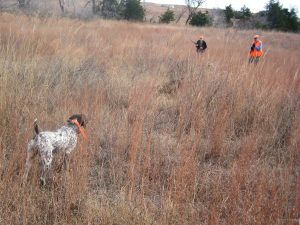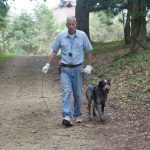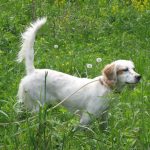Dos and Don’ts
POINTING DOG POINTERS June 2019
By Bob and Jody Iler
Through the years, as pups come into our kennel for training, we may find that some of them also come with problems! One example might be the pup that has lost his motivation to hunt because of overuse of the e-collar. Another young dog may have no enthusiasm or drive in the field because of too much training pressure put on him, with unrealistic expectations for the pup’s age. Another pup may want nothing to do with birds because of improper bird introduction.
The list goes on and on. It’s much easier to start off with a clean slate when training a pup. When we’ve completed a three-month started dog training program one, we always give our client a sheet with a list of dos and don’ts to keep handy and refer to as he or she continues to develop the pointing dog. Normally, it takes several seasons of hunting before the young dog starts to put it all together.
Here’s our list of things to consider when working with that new started pup. Remember: An “ounce of prevention” is always worth more than “the pound of cure.”
DOs
- DO take the pup out by himself, without other dogs, to hunt.
- DO hunt the young pup by yourself, without other hunters, at least the first few times.
- DO check with the farmer regarding any animal traps before hunting the farmer’s property.
- DO acclimate and socialize your pup by exposing him to chickens and cattle.
- DO hunt quail and pheasants, if possible, initially.
- DO hunt broom grass, picked corn, and cover that’s easier for a young dog to negotiate.
- DO hunt isolated and safer areas.
- DO keep shooting to a minimum. One or two shots per bird, and just one hunter shooting at a time.
- DO hunt with other knowledgeable dog people.
- DO hunt puppies as often as possible, but make sure they find some birds where you hunt. Birds make a bird dog!
- DO get puppies into birds at game preserves, especially if the places you are hunting are scarce on birds.
- DO use quail that are good flyers as you continue to develop your pup.
- DO make retrieving fun at this stage.
- DO keep your lessons positive, short, and fun.
- DO spend as much free time as possible with your pup to strengthen the bond between you.
DON’Ts
- DON’T leave home for a hunt without a first aid kit and water for your dog.
- DON’T hunt your pup if the weather is too warm. A temperature that seems all right to us can be harder on a pup that is working his heart out running in cover. He won’t know enough to stop, and you’re the one with the brains to make sure he doesn’t overexert and overheat.
- DON’T hunt your pup on opening weekend if it’s too crowded with other hunters and guns.
- DON’T hunt your dog in standing corn. You want to be able to see him point, and it’s also easy to lose a young dog in standing corn.
- DON’T start your pup out on grouse unless you have no alternative birds. Grouse often sit in the trees, flush wildly, and the pup may not even see the bird.
- DON’T hunt with three or four people shooting over one young dog.
- DON’T use automatics set up with five shells.
- DON’T hunt your pup with older, seasoned dogs. Seasoned dogs can steal the show and keep your pup from learning new and valuable lessons.
- DON’T shoot a bird your pup is not working.
- DON’T hunt with “meat hunters” who must fill their limit at any cost to your young dog.
- DON’T hunt near busy roads or railroad tracks with young dogs.
- DON’T run puppies “just for exercise” too much, especially at first. We want them to know what they are out there for, and to keep focused on finding birds.
- DON’T end a lesson or hunting experience with a train wreck – this is preventable by following our dos and don’ts!
- DON’T leave your pup sitting in a kennel with no socialization and companionship, taking him out only to hunt.
- DON’T use noisy bird launchers on young, inexperienced pups.
- DON’T put too much pressure on a young dog.
- DON’T worry if pup is not a natural retriever in the early stages.
- DON’T start a forced retrieve program with the young dog until he has had at least one successful season of hunting.
- DON’T use the e-collar on a young started dog, especially during his first season of bird work. Never use an e-collar at this stage to make corrections on your pup, particularly in bird work. Use your reliable checkcord!
- DO keep puppy bird crazy when hunting and don’t overuse the gun. Should you notice pup hesitate at the shot, this indicates a potential problem where pup may quit hunting. Return to bird work only and restore his enthusiasm before beginning to shoot, sparingly, again.
These guidelines supplement the many columns and magazine articles we’ve shared with you over the years. Our goal has always been to develop the pup in a quiet, kind and gentle manner suited to pup’s temperament. All pups need time to be “kids” and to make mistakes and learn as they grow. Your dedication and patience during this process will reap big rewards – just give your pup the time he needs!
Pointing Dog Pointers features monthly training tips by Bob and Jody Iler, who own Green Valley Kennels in Dubuque, Iowa. Bob and Jody have trained pointing dogs for over 35 years and have written many articles for The Pointing Dog Journal.








